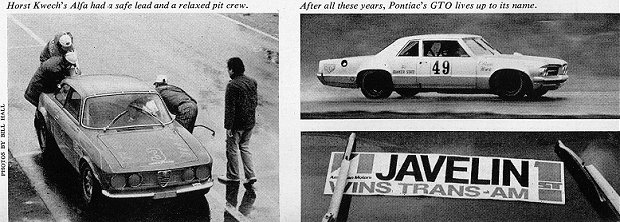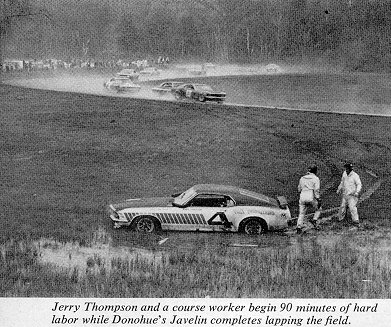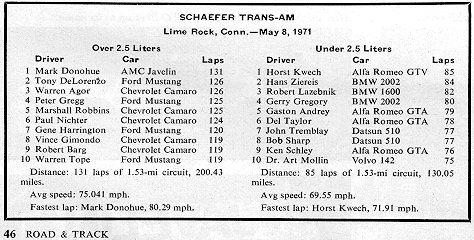Lime Rock Trans-Am: The American Motors Cup

Or, as the Admiral said to the Queen, nobody came in second
by Allan Girdler.
Lime Rock Trans-Am: The American Motors Cup

Or, as the Admiral said to the Queen, nobody came in second
by Allan Girdler.
THE CHECKERED FLAG still fluttered over Mark Donohue's Javelin when POP! from the glovebox of every American Motors car at Lime Rock came a bumper sticker proclaiming Javelin's victory at the first 1971 Trans-Am. The Penske team and AMC were obviously confident and their confidence was not misplaced. But the credit isn't theirs alone. The Javelin had help, from the competition and from the nature of professional road racing.
Last year there were frankly factory teams from AMC, Ford and Chrysler, plus the Chaparral Camaros with semi-obvious technical help and the T/G Firebirds with help concealed from all but the sharpest eyes. Ford won, and quit winners. The others were there to win, they didn't, and they didn't come back.
AMC excepted. During the winter Penske persuaded and Donohue perfected. When tech inspection opened, there was the Javelin with dry sump oil system, bulged fenders, tested rear spoiler, flush-front grille, in short, everything a Trans-Am car could wish for. No wonder they printed those stickers beforehand.
The opposition was darned near overpowered. Parnelli Jones was there on a temporary basis. Ford dealers in New York and Connecticut paid Jones and backed Bud Moore for this race only. No sense flying the flag beyond the sales district. Then there was American Racing Associates, last year's best fully-independent Camaro team now serving as the Javelin Junior Varsity. Tony DeLorenzo and Jerry Thompson switched from new Camaros to ex-Bud Moore Mustangs, there were no Barracudas or Challengers, etc. Understand, the private entries were well prepared and evenly matched. But the Trans-Am is no longer a factory battleground.
For entertainment, we turn to an underdog of mysterious origins, Bob Tullius, best known for his production car work under the Group 44 banner, turned up in a 1964 Pontiac Tempest, of the model known as GTO.
This must be true. You couldn't make it up. 'Way back in 1964 Pontiac brought out a performance car and enraged the purists by lifting the GTO designation heretofore used by Ferrari. What wasn't known then was that somebody at Pontiac had a conscience. To justify the designation the appropriate papers were bled and the GTO was duly 'omologated. A gesture, obviously and nothing much was done with the model's eligibility.

Enters now some engineers at Pontiac men who incidentally were involved with the T/G Firebird last year. They wanted to do some flag waving too, but were instructed from above not to mess with Firebirds because somebody might think the division was involved in racing. They knew that the GTO was eligible. And the wife of one of the group had a 1964 GTO with 80,000 miles on it, so naturally they prepared it for racing, de-stroked the 389 cu in, engine down to 303 with the help of a special crank they found somewhere, rounded up partial sponsorship from Heuer and Classic Wax and . . . you get the drift.
Heuer and Classic Wax are getting their money's worth. The crew could hardly back the car of the trailer for the swarms of fans, few of whom had ever seen a road-racing Pontiac before.
Donohue took the pole, followed closely by Jones and not too closely by everybody else. The GTO didn't qualify so it went to the back of the pack.
For the race, it rained. Donohue said later that his tires, wet-weather gumballs from Goodyear, deserved most of the credit for the win. Donohue led going into the first turn, with Jones just behind until the Mustang - on Firestones - went off course. The trip bent the left front fender into a tire slasher, and Jones retired after five laps. With no pressure on him, Donohue went just fast enough to stay alert, and even made his first fuel stop without losing the lead. At the finish, he was five laps ahead of 2nd-placer DeLorenzo.
While the winner wasn't being contested, there was lots going on. Tullius moved steadily up. (While not proposing that the SCCA adopt the Australian Pursuit technique so popular with the jalopy stock set, an occasional charge through the pack surely does make a good spectacle.) Four laps from the finish, the GTO was in second, admittedly well behind Donohue, but it billowed steam and Tullius retired. Involuntarily, actually; he tried to restart, so he could be classified as a finisher and get some prize money, but the engine wouldn't cooperate.
Jerry Thompson set a determination record. Early on he slid off the track, down a slope and into a large puddle of water, His Mustang sank belly-deep in the mud. He freed it after some 90 minutes, and got into the race in time to be qualified as 18th, or last of the finishers. Not quite the futile labor one might think. Finishing brought the team $200, so Thompson earned about $140 per hour.

But at Lime Rock we mostly saw our old friends in last year's rivalry, Alfa Romeo vs. BMW. There were six of the former and seven of the latter, plus two Datsun 510s, two Escorts, two Volvos and a Mini Cooper S. There were no Pintos and no Vegas. This may change as the season progresses, and it may not. Several engine builders are working on the Pinto but report no orders.
The Vega outlook is dimmer still. There are people working on the Vega engine. Their disconsolate report is that the engine's maximum so far, with stock head and intake manifold as the Trans-Am rules require, is 125 bhp. It is to laugh sadly. Further, the ohc design and equalization formula result in Vegas needing ballast. Worse yet.
The Datsun, though, shows promise. Datsun dealer/builder/driver Bob Sharp presented a very neat 510 at Lime Rock and qualified it in third position, behind the Alfas of Bert Everett and Horst Kwech. Sharp stayed with the leaders on this occasion until he had some minor mechanical derangements which dropped him to 8th at the finish. With a little development time, the Datsuns look to have a good chance in the series, and the series may not even need the domestic cars.
The 2.5 Lime Rock race was close anyway. Kwech had some bothers, too, and the early leader was Don Pike in a BMW 2002. He and Kwech swapped places until the BMW's engine blew at about the three-quarters point. Everett plowed into a sandbank, from which he couldn't get it out. So Kwech won and BMW driver Hans Ziereis was second, making for a nice points battle in the future. From there down to Sharp's 8th, it was all Alfa and BMW.
Perhaps there should be something like this in road racing series for manufacturers- American Motors, Penske and Donohue have paid their dues, taken their lumps while building a competitive car. They are nearly certain to win the title this year, and they deserve to win. They also deserve to have somebody finish second.
